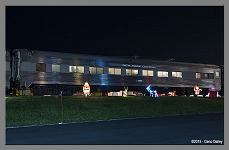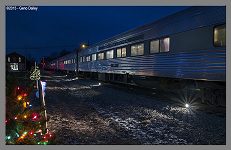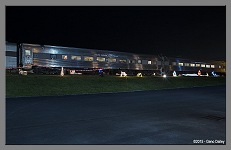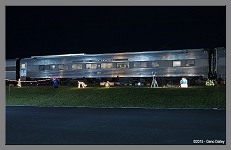| Back to Passenger Cars |
CAR DEPARTMENT WORK ORDERS - 2015
by Rick Henn
| The weather today (2/6/15) is bitterly cold, windy and there is a fresh coating of snow on the ground. So, it probably isnít surprising that there is nothing to report in terms of progress from the Car Department. For now and until the weather breaks a bit the cars are left waiting. However, that does not mean things are not going on. In January a crew removed the brake valves and delivered them to Pittsburgh Air Brake Company to be rebuilt. As soon as they are ready it will mean another trip to Pittsburgh to retrieve them and then get them installed on the cars before the new excursion season. The Car Department is also planning for the upcoming work season. Another issue is a need to replace the flooring in the aisles at the ends of the cars and maybe down the center aisle too. This was something that we looked into at the annual January conference of the Railroad Passenger Car Alliance. You might remember that we hosted this conference two years ago and that it is a gathering of private car owners and operators from all over the US and Canada. This year one of the vendors was a company that supplies transit flooring and we looked at several of their products. One looks very promising as a replacement for the aisles mentioned above. Besides these major projects there is a laundry list of other things to be done. (2/11/15) - On a cold Wednesday I took a trip to Medina. I had several reasons for going but one thing I wanted to do was measure the steps on the coaches so I could explore getting new treads to replace the worn and slippery ones now in place. So, I trudged through waist deep snow (okay it was maybe knee deep but waist deep sounded better) to get the necessary measurements. In either case it wasnít fun. After that the next step was to contact suppliers of transit flooring and step systems to find out what was available and what costs were. There were several options ranging in price from quite inexpensive to somewhat costly. Several things had to be taken into consideration in making the choice. Of course, cost is important but that has to be weighed against longevity of the product. It doesnít always make sense to go cheap now and have to do it again in a few years when a more expensive product now might last twenty years. Not only might it be less expensive per year in the long run but it frees up the Car Department from having to do it again. The ultimate concern in this case was safety. As I said above, the steps have become slippery, especially for children. We needed to install something that was a known quantity as far as being safe. The Car Department is one committee very much in need of more hands to get things done. The current crew is great and they give everything they can but there is so much to do. We need people with metal working skills, carpentry skills, electrical skills or no special skills at all, just a willingness to learn. Oh, maybe with the new flooring to be installed we could use some carpet installers too. (2/23/15) - I got an email from Mike Jubeck at PABCO that the brake valves and hoses are ready for pickup! |
| AGENDA FOR CAR DEPARTMENT PLANNING MEETING 3/1/2015 |
Must do items:
|
| (3/1/15) - At the March 1 meeting we also discussed upcoming jobs that need to be done and budget concerns. To that end the Car Department, decided to go with the more expensive but safer and longer lasting product. The new treads will have a white rubber nose with a gray step. The cost will be about $1,300 to do the north side steps, which are the ones most used. So, if you are in a mind to donate to a project consider this for the Car Department. We also discussed upcoming jobs that need to be done and budget concerns. There are a lot of things we can do that will not cost us any, or very little money, but we need more hands to get the jobs done. Since you will be reading this in May I hope the snow piles and cold weather will be long gone and just a ďfondĒ memory so the thought of coming out to help will not be spoiled because of the weather. (3/16/15) - Another preliminary step was taken in preparation for the upcoming season of trips. Art Toale and I went to Carnegie PA to Pittsburgh Air Brake to pick up the recertified brake valves and new end hoses. The weather was good all the way there and back but along with the parts we would have liked to bring back some of the Carnegie weather. It was sunny and in the sixties. Next comes the work part, which is installing the valves and testing the cars. |
| I canít speak for the other guys but when Monday morning rolled around my muscles, which were not used to that work, were screaming at me and I am sure were calling me very not nice names. We completed the work the following weekend. George, Art, Dave, Brody, George and I returned to complete the installation of the valves and Dave, our Certified Airbrake Technician, was able to complete the man-datory single car tests to insure the brakes are all working properly. We encountered only one small problem when an o-ring slipped during installation of a valve and was cut into two pieces. Fortunately it was a smaller valve and the fix was simple. While we were there we also made repairs to two window sills and an end door. I cannot thank the guys enough for coming out to handle this job, from removing to reinstalling the valves. The weather was often very cold but they came out, braved the elements and got it done. |
| emergency brake application is made. The brakes respond faster and at a higher pres-sure to stop the train more quickly. The next valve is the brake application valve. This valves ďdumpsĒ the air in an emergency application. The last little valve is the in-shot valves that mounts opposite the relay valve and works as part of the relay portion. Not pictured is the conductorís valve, which mounts inside the car and is more commonly known as the emergency valve. Pull it, the air dumps and the train stops. Then you have some explaining to do to what will be a very upset engine crew. |
| The entire system works with slide valves, pistons and carefully machined passageways within each valve and is incredibly reliable. These cars are almost 70 years old and this brake system was not new to them. (Itís called a D-22 system if you are interested.) However, after sitting from the end of Polar Express in December until Thomas in May everything usually works the first time the train crew shows up and puts air into the system. |
So the warmer weather is just starting and who knows what April will bring. We do know that May will bring the start of the excursion season with the arrival of Thomas the Tank Engine. We always need more people to staff these trains so if you would like to work on them please  Rick H. so I can add you to the list. Rick H. so I can add you to the list. |
by Rick Henn
| 4/11/15 - George and I went to Medina and replaced the end hoses on the coaches. There were a couple of stubborn hoses but they gave in to George's 36 incher, pipe wrench that is. We were out and back in about 3 hours so a good day's work. 4/12/15 - Today Dave, Bill and I did a few odds and ends things on the coaches. Dave repaired a bad brake. We took turns working on window shades and Bill and I removed the last three door closers on the end doors. In many cases that was what made the doors so hard to open and most did not shut properly anyway. 4/19/15 - Art Toale, George Specht, Al Olmstead and I made our annual trip to Olean to prep the par-lor car for the upcoming season. It was a nice day for a ride in the country and, as usual, the car was parked on the raised yard tracks right by the road so it makes an impressive sight as you come around the curve leading to the yard entrance. Usually there is no activity in the yard on weekends, at least when we have been there, so the rail-road sends someone in to open the shop. Today, however, there was a shop crew working and we got to watch them put together a trio of locomotives, which then disappeared into the yard never to be seen again. The shop has four bays with tracks and a fifth that acts as storage and work space. I have to admit to drooling a bit at the thought of having something one quarter that size for our car shop. The folks down there are very friendly and gave us access to what we needed. The visit gave me a chance to meet the Chief Mechanical Officer Carl Went-worth and Al and I chatted with Chief Operating Officer Carl Belke. There were only minor issues with the car. Art and I replaced end hoses while George and Al changed the battery and traced an electrical problem to a blown fuse. We adjusted a trap so it closed properly, tested the heat and the AC. Al topped off the AC coolant and George removed the foot release latch on the second trap to see why it wasn't working. It will have to be replaced. We repaired a couple of window shades, found a place to eat lunch, which wasn't so easy on a Sunday, and headed for home. It was a fun day and we got a lot done. 4/26/15: Al Olmstead and I adjusted the trap and step mechanism on the coaches so the traps operate properly. The system is designed to operate in such a way that, when open, the steps are locked in the down position and when closed the steps hinge up under the car so the outside presents a sleek appearance with no visible steps. All this is accomplished with a single strut that goes from the trap to the steps. The adjustments on the strut allow it work the steps and trap as a unit. The heavy spring inside the strut is also intended to cause the trap to pop up when first released. Another example of seventy year old or older technology that works fine without the help of electronics or computers. |
| 5/24/15 - Even though Thomas is long past, the Car Department has been doing other things instead of working on the cars. We spent time completing the air conditioning system for the church at HDC and then went on to carefully inspect the large AC unit that supplies AC for the entire building. 6/7/15 - We removed and replaced a motor with a bad bearing and looked at what other work was needed to get the unit up to full capacity. Hopefully we will be back to the cars soon but sometimes other things take priority and we do what needs to be done. If you have not visited the Heritage Discovery Center at 100 Lee Street in Buffalo in a while, you should put it on your list of things to do this summer. Not only are the displays in our part of the museum interesting but the Steel Plant Museum has great displays too. On top of that you can do a lot of train watching. Within thirty minutes after arriving to work on the air conditioning with George and Al, three trains had passed HDC. After that we went to work so I was not able to keep an exact count but there were twelve to fifteen more trains that went past in the next couple of hours. Come by when the museum is open (Tuesday, Thursday and Saturday from 10:00 AM until 5:00 PM). There is free parking and lots of lawn to sit down on and watch the action. Today there was a variety of CSX and NS trains along with light engine moves and foreign power. The most notable unusual power was a unit from Kansas City Southern of Mexico. Two trains came through with BNSF power in the lead. |
by Rick Henn
| It has been a long and sometimes hot summer and with the financial situation being what it was it was not easy to be productive. However, the Car department succeeded in doing that very well. Using materials that had been purchased previously we were able to complete many projects and make upgrades that were needed without spending a lot of money. Well, without spending a lot more money than what was spent to do brake valves and replace end hoses but those were necessities. So, see below for a summerís worth of work. 6/21/15: After being away from the cars since Thomas, today George, Al and I were in Medina to ease back into work mode. There were three goals for the day and we ended up with one, success, one not so much and one un-known. The success was removing a sliding foot plate that had become a trip hazard from a vestibule. George cut out the welds and will take it home to use as a template for a new one. The failure was my attempt to remove the smoke stained red carpet from the ceiling of 2906. I don't know what kind of glue they used but after more than 35 years it was not coming down easily. Have to do some research and experiment. The unknown was trying to correct the generator in 2941 from shutting down on over speed when it wasn't running over speed. George and Al adjusted the controls and it ran while we were there but it will take some longer running under more stressful conditions to know if it is fixed or if we need new electronic components. 6/18/15: Thanks to Dave, Bill and Brody for joining me in Medina yesterday. The weather pretty much precluded us from doing any of the outside work I wanted to do but we did some good inside stuff. First we found about a dozen good seat cushions in 2933 (the spare coach we have) and distributed them as needed to replace ripped and ragged covers throughout the train. The colors aren't an exact match but they are all blue and look better than what was there. Then we cleaned out some stuff from the tool room in 2906. A lot got thrown out because it was useless stuff and some will be moved to HDC either for storage or to be added to the scrap pile. A big future need will be upholstery for the cars, especially 2932. However, I am estimating and entire upholstery job at $12,000, which is pretty much the Car Department budget for the year. There were only minor issues with the car. Art and I replaced end hoses while George and Al changed the battery and traced an electrical problem to a blown fuse. We adjusted a trap so it closed properly, tested the heat and the AC. Al topped off the AC coolant and George removed the foot release latch on the second trap to see why it wasn't working. It will have to be replaced. We repaired a couple of window shades, found a place to eat lunch, which wasn't so easy on a Sunday, and headed for home. It was a fun day and we got a lot done. 7/19/15: George Specht, Bill Glodzik, Bill Davis and I worked on the coaches today. It was a steamy time but we did fine until about 2:00. Then the heat and humidity took their toll and we called it a day. However, Bill G. and I replaced the glazing in two more sliding windows. Bill Davis, who has graciously taken on the job of making win-dow sills, came out to see just how they were installed so he had a better feeling for what he was doing. George took measurements and pictures of a vestibule buffer part that needs fabricating. Considering the weather it was a productive day. 7/26/15: George, Al and I welcomed a new crew member to the Car Department today. Cody Catlin joined us in Medina. We changed two more windows and scouted out some other things that could be done inexpensively. Cody fit right in and jumped right into whatever he was asked to do. It was a good day but once again the heat and humidity took it's toll so the day was cut a little short. Cody has been active with the Medina Railroad Museum for several years and just recently joined the WNYRHS and the Car Department. In Medina he has been a chef for Polar Express trips and has worked Thomas the Tank Engine weekends. We are glad to have him aboard. |
| While the new treads are not original, they look good and are much safer. While this was going on, Bill, Anna and Cody replaced three more sliding windows. There is only one left to do. It was a very productive day indeed and I thank all of you that came out. By the way, going back to June, the adjustments to the generator in 2941 worked and it has not shut down since. 8/16/15: During the week since our last work session Art Toale took the remaining steps home and, using a metal cutting blade on his table saw, cut them to the proper depth. That make our work today much easier. George drilled the holes and set the steps in place so Cody could come along behind him and pop rivet the new steps (treads) to the old ones. The new treads provide much better grip and will be much safer, especially for the kids. While they did that, I repaired window frames. By the time we were finished the train was ready for the start of the excursion season on August 23rd. |
| Once in there, it was a matter of aligning the pulleys and belt and adjusting the tension. It might sound easy but after who knows how many years of not being moved the adjustment screws groaned and creaked with every turn of the wrench. Additionally, as you will see in the pictures, there was not a lot of room to work. Iím not sure how it worked out that the biggest of the three of us was the one that spent the most time curled up in that tight space but, as you can see, he did it with a smile, at least when the camera was pointing at him. A blown fuse had to be replaced and now the exhaust fan is back in operation. While all this work was accomplished we had a rather constant parade of trains to contend with. Yeah, we are railfans so whenever possible the work stopped long enough to at least see what was going past. It was quite an interesting day and busy on the railroads. One advantage of rail fanning at the HDC as opposed to the Depew station, is that the NS traffic that is on the other side of Broadway in Depew but is right in front of you at the HDC. Norfolk Southern and the Buffalo & Pittsburg add some nice variety. |
by Rick Henn
| Following is a summary of what has been done. One Sunday was spent with a nice sized crew consisting of Al Olmstead, George Specht, Dave Fleenor, Cody Catlin, Brody George and I. George got the crappy job, literally. He had to replace the pump in the toilet in coach 2941. Oh for the days when you could just dump it on the tracks and stare at the ties flashing by! Dave took Cody and Brody and showed them how to repair cables on window shades while Al and I repaired light fixtures. Cody and Brody also replaced burned out lights and I cleaned out the tool room in 2906. At a later time I cleaned out the other storage rooms. It won't be long before the museum will be needing the space for hot chocolate and cookies for Polar Express. The New York Central used a system of criss-cross cables to control the window shade position. Basically, it stays wherever you put it because of the cables and the tension they provide working against the tension of the roller trying to pull the whole shade up. When they break or come lose they tend to form a loop and that looks bad and becomes an issue for people getting their hands caught. So, those were all repaired and any other work that could be completed on the shades was also done. The problem with most of the light fixtures seems to be the result of newer bulbs not having as large a contact area on the base of the bulb. I am talking about the very bottom. Because there is less solder there it does not reach the bottom of the socket. That meant going into the socket with a small tool to bend the contact up so it would touch the bulb. As I have said before, George always gets the worst jobs. If you havenít seen the cars, the toilets are a pump handle design like used in an recreational vehicle. The pump sits in the bottom of the toilet, which is also the part that holds the waste until the toilet is dumped. Even when the toilet has been dumped and flushed out, it is still a messy area and trying to work in the confined space of the lavatory makes it worse. Starting right after Thanksgiving the cars will be busy every weekend until the weekend before Christmas for the Medina Polar Express trips. If you have never taken a ride, it is great family fun and I highly recommend it! Our next installment will probably be mostly about plans for next year. Have a wonderful Holiday Season! |
by Rick Henn
| Since November 28th and 29th our passengers cars have been in revenue service carrying hundreds of young and old on the Medina Railroad Museum's "Polar Express" rides. Almost every train has been a sell out with the warmer weather we have enjoyed here in Western New York. To date the cars have performed very well with very few complaints thanks to all the work we put into the cars back in the fall. Society member Geno Dailey was out with his camera on the very cold Saturday, December 19th trip and captured these beautiful pictures below. Thank you Geno for sharing this pictures and braving freezing temperatures! Wishing all of the you the Best of the Holiday Season and sharing your joy with Family and Friends! |
 |
 |
 |
 |
Web Site Hosting by TRAIN WEB
The WNYRHS, Inc., 100 Lee Street, Buffalo, NY. 14210 is an independent organization and has no affiliation with any other local or national group.
The Society is a fully qualified organization under 501 (C) (3) of the Internal Revenue Code and all donations to the Society are tax deductible.
©Copyright 1999 , WNYRHS Inc. all rights reserved